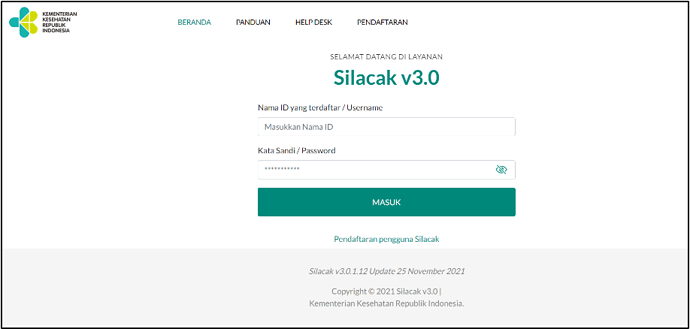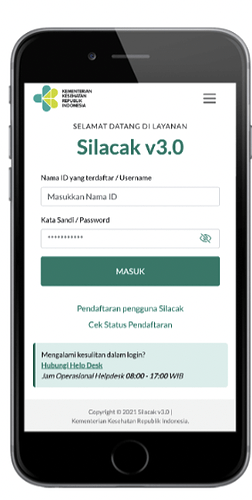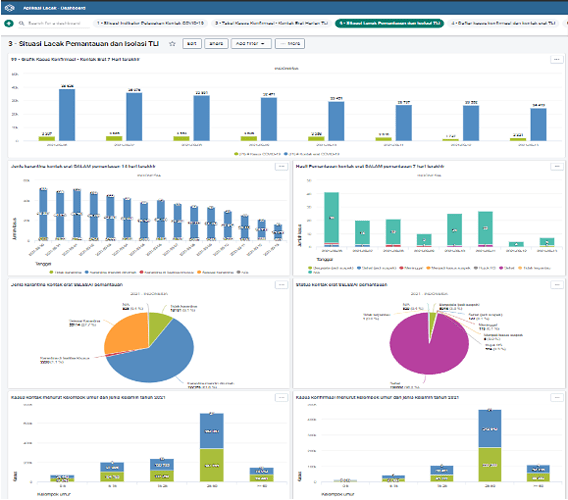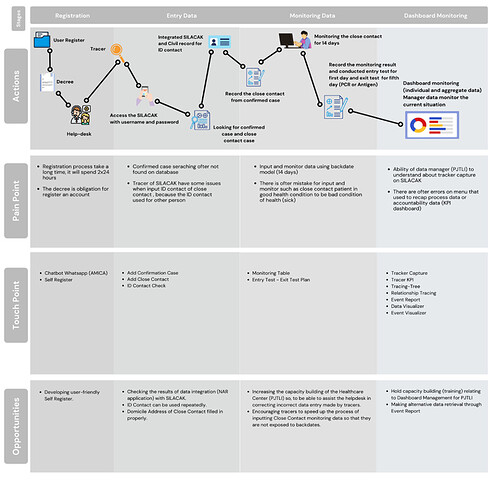INTRODUCTION TO INDONESIAN CONTACT TRACING
When the novel coronavirus SARS-CoV2 hit China most severely during the months of December 2019–February 2020, Indonesia reported no cases of infection at all. Only on March 2, 2020, the first case of COVID-19 in Indonesia was announced by the President where two people were infected after having contact with a Japanese citizen which was confirmed positive at a multi-national dance party. Since 11 March 2020, when there were already 27 cases reported, the public started to critically demand data transparency from the government. After the initial and subsequent reports of infections, Indonesia started to realize the direness of the situation and has since issued various policies and actions to tackle COVID-19, including appointing 100 domestic general hospitals as Referral Hospitals and providing live data on COVID-19 impacts in Indonesia that are presented on this newly established website of https://www.covid19.go.id/.
Eighteen months after COVID-19 began to spread in Indonesia, on September, 18th 2021, the country had reported 4,188,529 confirmed cases of COVID-19 of which 3,983,140 patients recovered, 140,323 patients died, and the remaining were still in treatment. COVID-19 vaccines have been given by the government since January 2021. By September 2021, 37.96% of the target population of 208,265,720 citizens had gotten the first dose, and 21.58% had received a second dose. The government and other stakeholders continue their efforts to decrease the numbers and stop the spread of COVID-19 in Indonesia.
Currently, information technology and digital transformation in Indonesia is still in progress, especially during the COVID-19 pandemic. Contact tracing is now an area of concern, because a virus carrier who tests and gets a positive result may have already spread the virus to other people who have been in contact with them, and people who are infected may or may not have symptoms. Contact tracing is a strategy to reduce virus transmission caused by asymptomatic people. The role of information technology is creating the system for contact tracing to stop the transmission of the virus.
To take advantage of the benefits of the information system mentioned above, digital transformation is needed, because it will make all the systems of a country integrated and make it easier to control and monitor all the data. The Indonesian President Regulation Number 39 of 2019 on One Data Indonesia (Regulation 39/2019) integrated all of the government institutional systems. Due to the complexity of data, especially health data from the COVID-19 pandemic, the Indonesian Ministry of Health (MoH) is using the District Health Information Software Version 2 (DHIS2) platform, as recommended by WHO for integrated health data as a data warehouse (WHO Report). DHIS2 is an open-source, web-based, used as a Health Management Information System (HMIS) for more than 70 countries. This platform serves as a data warehouse for health management system, allowing users to collect data, analyze data, and visualize data results.
The contact tracing system implemented in Indonesia is called SILACAK (which is basically and adopted and modified DHIS2 COVID-19 metadata package). The Indonesian government has confirmed SILACAK as the only official contact tracing tool in Indonesia in the Ministry of Health Decree Number HK.01.07/MENKES/4641/2021 on the Guidance on Testing, Tracing, Quarantine, and Isolation on Preventing COVID-19 that was published on May 11th, 2021.
As a DHIS2 implementation, SILACAK not only includes aggregate data, but also individual data. The aggregate data, such as the number of confirmed cases and their contacts measured at a national or regional level over a period of time, is used to perform data processing and analysis, while the Individual data includes information such as the contact tracing patient name, address, contact number, lab test date, and civil records ID number, and is used to monitor the close contacts of a virus carrier to stop the spread of COVID-19.
HOW INDONESIA DEVELOPED A CONTACT TRACING APPLICATION THROUGH DHIS2
Uploading: image.png(1)…
Figure 1. Silacak Interface Login (web and mobile)
In designing SILACAK as a contact tracing system platform, the team created a dashboard following national guidelines, which is a tool to monitor the COVID-19 cases in Indonesia and support decision-making for stakeholders. Later on, this dashboard was used for situational analysis regarding restriction regulation in Indonesia. Between November 2020 and February 2021, the MoH and the National Taskforce recruited around 6000 contact tracers to work in 13 priority provinces, and later expanded this activity to the remaining 21 provinces in Indonesia. More than 80.000 tracers were targeted to be recruited to respond to the increasing trend of COVID-19 cases in Indonesia.
The contact tracers work with the SILACAK system. SILACAK has been developed into two applications, one for data entry that is used by the tracer to enter and monitor daily updates from contact patients within 5 days (those who are doing entry and exit test), then 14 days (for the patients who won’t do the test. The other application is called SILACAK Dashboard, which is used by the data managers/facility coordinator (PJTLI) to monitor and overview the COVID-19 data. This
Dashboard is built to visualize and provide the data needed by the facility coordinators, leaders, and stakeholders to see the current pandemic situation, status, forecast the future, and support decision-making. Some key indicators and outputs are:
- Percentage of COVID-19 cases tracing for Close Contact;
- Ratio Close Contact COVID-19 cases;
- Percentage of Close Contact cases monitored;
- Sum of Close Contact cases monitored;
- Total of COVID-19 cases;
- Total of Close Contact cases;
- Total of Exit and Entry test for Close Contact cases;
- Quarantine of Close Contact cases;
- Close Contact cases monitoring result;
- Percentage of Close Contact cases quarantined has been monitored;
- Total of Close Contact cases based on gender and age; and
- Total of COVID-19 cases based on gender and age,
Figure 2. Silacak Dashboard
In developing SILACAK through DHIS2 to collect, process, and analyze information regarding COVID-19 data, HISP Indonesia has also developed a mobile version of SILACAK, designed as a Progressive Web App. The Mobile version of SILACAK was developed through several stages to accommodate the needs of contact tracers and users, starting from the need to make it possible for tracers to use it in offline mode. This feature helps contact tracers who lived in areas without good internet connection. This mobile version can be accessed in the form of a website or through the SILACAK application, which can be downloaded via the Google Play Store (for android users only).
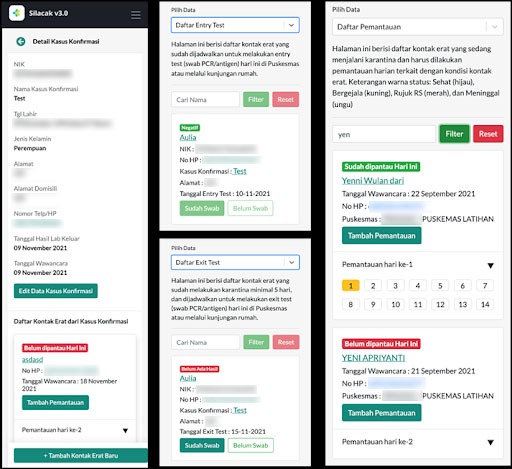
Another feature related to the monitoring and display of close contacts cases has been developed to make the app easier to use by using a monitoring table that is set according to the monitoring scenario used in contact tracing in Indonesia. Furthermore, SILACAK was also developed to integrate with New All Record (NAR) as an application to record the COVID-19 confirmation cases. Based on the results of the NAR test (PCR and Antigen) for PCR, a Confirmation Case will be obtained which will then be entered into the SILACAK system and sent to the tracer account in charge where the Confirmation Case is domiciled, so they could have to track their Close Contacts. The integration between NAR and SILACAK helps tracers in tracking the Close Contact, because they no longer need to search the Confirmation Case data and put in one-by-one first, thus making the tracking process more effective and efficient.
This integration makes it easier for tracers to monitor each confirmed case of COVID-19, so that it will shorten the data entry process for close contacts because there is no need to manually enter the data for Confirmation Cases one by one.
In collaboration with the Digital Transformation Office (DTO), HISP Indonesia recently developed SILACAK mobile version 3.0 that can cover all of the user’s needs, for example the need to migrate cases using the tracer application, which is nowmore user-friendly compared
to the previous version. At this moment, the final version of V3.0 application is in progress led by DTO to ensure easy access and improved performance. In addition to easy case migration, this version also allows the tracers to evaluate their performance/KPIs. So with the development of SILACAK, which has been designed with a user-friendly and integrated data source, it is hoped that the monitoring process will be more effective and efficient because users can receive early notification if new cases are reported, which can then be followed up by conducting contact tracing and quarantine monitoring.
In addition, the Indonesian DHIS2 team also made innovations on the users registration system, to support the users and data managers on getting their accounts, by developing a users self-registration tool called AMICA (based on Whatsapp), so that, in less than 5 minutes the users could receive their personal account by registering and followed the instruction given in the chat column. The account can be used right after they get the username and password. Besides developing AMICA Whatsapp Chatbot, the team created a web-app based self-registration and approval system that can be accepted directly by the data managers/PJTLI at the district level. This registration app can be accessed on https://reg-silacak.kemkes.go.id/. So, with developing the DHIS2 menu (User Management) through SILACAK registration system, the process on getting account that previously took a lot of time, has become efficient and effective.
Besides the NAR integration which helps the close contact monitoring process, there is another integration conducted between SILACAK - PeduliLindungi application that is used in the implementation of Health surveillance by the Government of the Republic of Indonesia in dealing with the spread of COVID-19, including tracing, tracking, warning and fencing in the territory of Indonesia and in order to facilitate a new order of life (new normal). The users are Indonesian or any person who downloads, opens, uses, and/or accesses PeduliLindungi in correlation with SILACAK, the close contact cases are sent to PeduliLindungi where if a person is in close contact with a confirmed case of COVID-19, the color of their PeduliLindungi status will turn black. So that, the close contact case can be monitored perfectly because they can comply with the quarantine procedure and cannot travel around or be restricted to reach the public areas which result in continuing COVID-19 transmission.
Figure 4. Silacak User Journey
CONCLUSION
The development and implementation of SILACAK through DHIS2 has been carried out with the creation of a mobile version of SILACAK for tracers, which has been developed to the final version V3.0 to ensure easy access and improved performance. In addition, there is also the development of a registration system for tracers, which was initially developed through the WhatsApp chatbot (AMICA) and has now become Self Register, which has succeeded in shortening the length of the account creation process. Furthermore, the implementation of DHIS2 on the contact tracing application has been developed by integrating SILACAK with the New All Record (NAR) and PeduliLindungi application. This integration helps Indonesian COVID-19 response by ensuring peoples’ compliance with quarantine procedures and travel restrictions to help prevent continued COVID-19 transmission. In relation to data use, SILACAK facilitates the use of both aggregate data and individual data. The individual data is used to help in recording the close contacts monitoring data, and the aggregate data help in performing the data processing and decision making.
